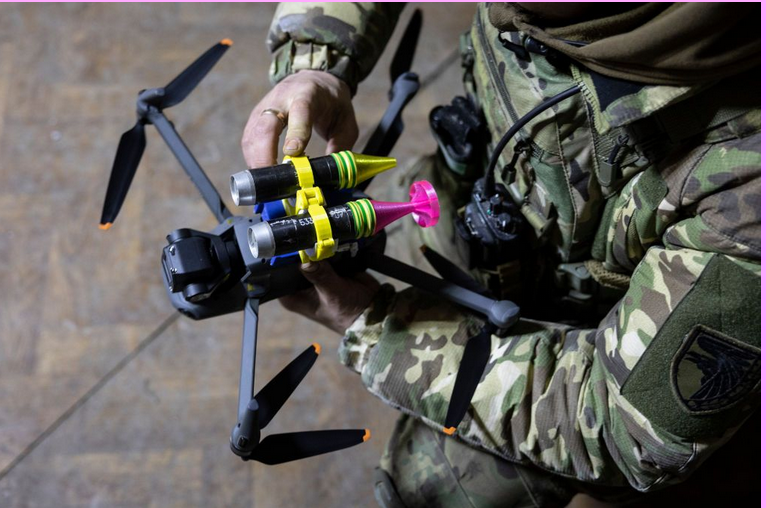Russia invaded Ukraine on February 24, 2022, shocking the world. Since then, new technologies have enabled Ukraine to organize its defenses and even roll back the Russian invasion. Two key pieces of tech have helped turn the tide: small, inexpensive hobbyist drones as well as portable satellite internet. Western armies will quickly follow Ukraine’s lead.
The all-out invasion by Russia, meant to subjugate Ukraine and bring it into Moscow’s imperial orbit, was meant to take three days, yet the war still rages on with no end in sight. This upset guarantees that no matter how the war ends, it will be studied for years to come.
Every major war—and even many minor ones—introduces new technologies that disrupt the old order. World War I introduced European armies to the machine gun, which devastated infantry attacks that had been so effective beforehand. World War II introduced the aircraft carrier; the Vietnam War introduced the helicopter and satellite communications; and the post-9/11 wars saw the first use of GPS and high-flying surveillance drones. While drones have been used in wartime since Vietnam, and most recently in the 2020 Nagorno-Karabakh War, the war in Ukraine has seen an unprecedented use of the unmanned aerial vehicles. Even before the war, the U.S. military was planning to adopt drones in a big way. Marine infantry would go into battle with small recon drones, tanks and fighters would have “robotic wingmen” to protect them, and overhead drones would provide surveillance data, air support, and communications.
The swiftness of the invasion, and Ukraine’s lack of means to resist it, forced Ukrainians into adopting small, hobbyist-grade drones for missions they were never designed to carry out. Ukrainian forces have used quadcopter drones for battlefield reconnaissance and surveillance; as flying communications nodes; to resupply forces in the field; conduct precision-guided strikes; and even attack other drones. Some of these drone missions were foreseen by the Pentagon, but never tested in wartime: in Ukraine, these missions were carried out and proven viable within days of the invasion. Ukraine’s successful use of small, inexpensive drones means they will be around to stay—and are likely to take on even more roles. The drones are flexible enough to carry out almost every mission imaginable, and cheap enough for armies, especially those like Ukraine, to continue experimenting with them and pushing the limits of the possible. Like Darwin’s finches exploring the Galapagos, the highly adaptable drones will expand into every niche of modern warfare.
Source - https://www.popularmechanics.com/military/a43059674/how-drones-and-satellites-turned-the-tide-in-ukraine-russia-war/
The all-out invasion by Russia, meant to subjugate Ukraine and bring it into Moscow’s imperial orbit, was meant to take three days, yet the war still rages on with no end in sight. This upset guarantees that no matter how the war ends, it will be studied for years to come.
Every major war—and even many minor ones—introduces new technologies that disrupt the old order. World War I introduced European armies to the machine gun, which devastated infantry attacks that had been so effective beforehand. World War II introduced the aircraft carrier; the Vietnam War introduced the helicopter and satellite communications; and the post-9/11 wars saw the first use of GPS and high-flying surveillance drones. While drones have been used in wartime since Vietnam, and most recently in the 2020 Nagorno-Karabakh War, the war in Ukraine has seen an unprecedented use of the unmanned aerial vehicles. Even before the war, the U.S. military was planning to adopt drones in a big way. Marine infantry would go into battle with small recon drones, tanks and fighters would have “robotic wingmen” to protect them, and overhead drones would provide surveillance data, air support, and communications.
The swiftness of the invasion, and Ukraine’s lack of means to resist it, forced Ukrainians into adopting small, hobbyist-grade drones for missions they were never designed to carry out. Ukrainian forces have used quadcopter drones for battlefield reconnaissance and surveillance; as flying communications nodes; to resupply forces in the field; conduct precision-guided strikes; and even attack other drones. Some of these drone missions were foreseen by the Pentagon, but never tested in wartime: in Ukraine, these missions were carried out and proven viable within days of the invasion. Ukraine’s successful use of small, inexpensive drones means they will be around to stay—and are likely to take on even more roles. The drones are flexible enough to carry out almost every mission imaginable, and cheap enough for armies, especially those like Ukraine, to continue experimenting with them and pushing the limits of the possible. Like Darwin’s finches exploring the Galapagos, the highly adaptable drones will expand into every niche of modern warfare.
Source - https://www.popularmechanics.com/military/a43059674/how-drones-and-satellites-turned-the-tide-in-ukraine-russia-war/
